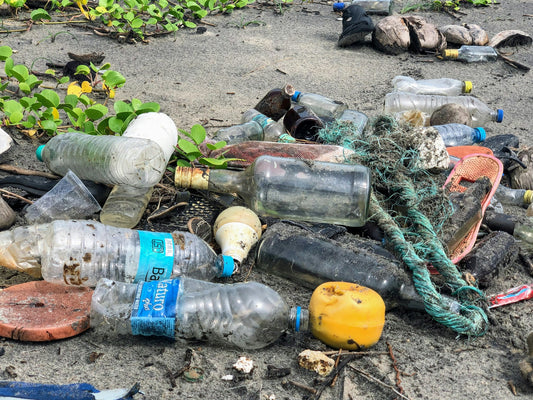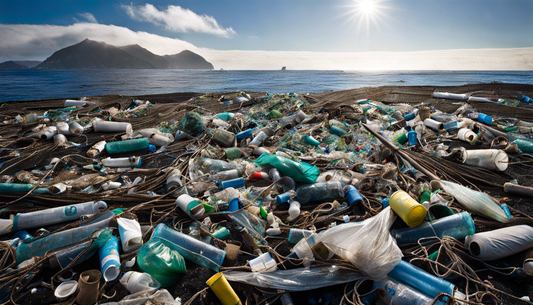Share
Plastic has become a common material in our society today, and it is hard to imagine a kitchen without it.
Plastic materials are used in various parts of food processing and preservation, including cutting boards and containers.
However, with the recent awareness on the effects of plastic on the environment and health, many people are now looking for alternatives.
If you also want to play your part in saving the environment by going plastic-free in your kitchen, then this guide is for you. Here, we will find some of the best plastic-free products that you can use for food preparation and storage.
How do Microplastics Harm the Human Body?

These particles are very tiny and can easily find their way into our water systems, the soil, and the food chain.
Research reveals that microplastic has infiltrated human blood, organs, and even the placenta of unborn babies.
Microplastics are capable of accumulating toxic substances within their matrices from the surrounding environment, including heavy metals and pesticides.
This absorption may lead to increased exposure to these toxic substances when microplastics are ingested.
The main route through which humans interact with microplastics is through food chain and drinking water and it is estimated that an individual can consume up to 52,000 microplastic particles per year.
The effects of microplastics on human health have not been fully understood and established, but some of the preliminary studies have associated them with hormonal imbalances, low fertility rates, and even cancer.
Origins of Microplastic in Food Preparation and Storage

Microplastics enter our food chain through a variety of sources, many of which are commonly found in kitchens.
Plastic Cutting Boards:
Each time you are cutting vegetables or bread using a plastic chopping board, you are likely to end up consuming small particles of plastic.
They remain in your body and accumulate as time goes by, causing negative impacts on your health.
Plastic Utensils:
Like cutting boards, plastic utensils can wear out, and using them with hot foods may cause them to break down.
This breakdown leads to the liberation of microplastics in your meals.
Plastic Storage Containers:
When the food is warm, storing it in plastic containers can lead to the BPA and phthalates being released into the food.
Plastic-Free Food Preparation Items

You may be thinking that going plastic-free in the kitchen is a difficult task, but it is actually rather simple.
Below is a list of some of the best options that can assist you in eradicating plastic from your food preparation activity.
1. Cutting Boards
A good cutting board is one of the most important accessories that can be used in the kitchen. Instead of using plastic cutting boards, one should consider purchasing a bamboo cutting board such as the Bamboo Cutting Board & Serving Tray.
Bamboo is not only strong but also anti-bacterial, so it does not breed bacteria like plastic chopping boards do.
Moreover, bamboo is renewable because it grows fast, and it does not require any chemicals such as pesticides and fertilizers to grow.
2. Utensils
Convenience is a major factor in why many people use plastic utensils. However, they are very unsafe. They can contaminate your food with dangerous chemicals, especially when exposed to heat.
A better solution is a Reusable Cutlery Set, which is made from bamboo or olive wood. These sets are not only environmentally friendly but also long-lasting.
3. Bowls
Bowls are versatile and are used in the kitchen for mixing, serving, or even eating. The Mediterranean Olive Wood Multi-Functional Bowl is an elegant substitute for plastic bowls.
Olive wood is well known for its durability and antimicrobial properties, which are ideal for food preparation. The bowls are individual, and the natural grain design gives a touch of class and sophistication to your kitchen.
Plastic-Free Storage Solutions

It is highly important to store your food correctly if you want to keep your meals tasty and healthy. Below are some of the plastic-free storage solutions that are both effective and eco-friendly.
1. Containers
Glass and wood are the best options for avoiding plastic when storing food products. The Mediterranean Olive Wood Multi-Functional Cannister is a good storage container if you're looking for wood options.
Its lid fits well, ensuring that the food remains fresh even without the use of dangerous plastics. Additionally, olive wood does not retain any smell or stain, which means your food will not be contaminated in any way.
Alternatively, glass bowls or even mason jars make great and beautiful storage solutions for your sustainable kitchen.
2. Beeswax Wraps:
Beeswax wraps are one of the best alternatives to plastic wraps that you can find in the market.
These are made from organic cotton that has been coated with beeswax, jojoba oil, and tree resin; they are biodegradable and compostable.
This means that once they reach the end of their life, they will not be a source of adding to the pile of plastics that are harming the environment.
Another benefit of beeswax wraps is that they are multi-functional. These can be employed to cover bowls, wrap sandwiches, store cheese and so on.
You can even make your own beeswax wraps with our DIY beeswax wrap kit!
3. Produce Bags
When buying fresh produce, avoid using plastic bags. Produce bags are reusable bags manufactured from natural fibers.
They can be used over and over, reducing the use of plastics. They are light and airy and can be used for carrying fruits, vegetables, and even large items.
4. Bulk Muslin Bags
If you are looking for a bag for bulk shopping, then Bulk Muslin Bags will be the best option.
These bags are made from unbleached cotton and are ideal for storing grains, nuts and other dry foods and staples.
They are reusable, easy to clean and can be used over and over, thus eliminating the use of plastic bags and containers.
A Few Simple Changes for a Healthier Life
As a first step towards an eco-friendly kitchen, begin swapping out your plastic products for more eco-friendly options.
- List down the plastic items you use in the kitchen and determine which of those you should replace as soon as possible.
- Begin with items that are most likely to come into contact with food, for instance, cutting boards, knives, and containers.
- Start with a particular part of the kitchen, for example, the area where you store your foods and snacks, and start replacing the plastic items with the green ones. This makes the process less overwhelming and more manageable.
By opting for sustainable options for cooking and preserving food, you are not only avoiding the intake of dangerous microplastic particles but also preserving the environment.
Shop Without Plastic has many products that make this change simple and fashionable. So, start today and begin your journey towards a plastic-free kitchen and healthier life.








